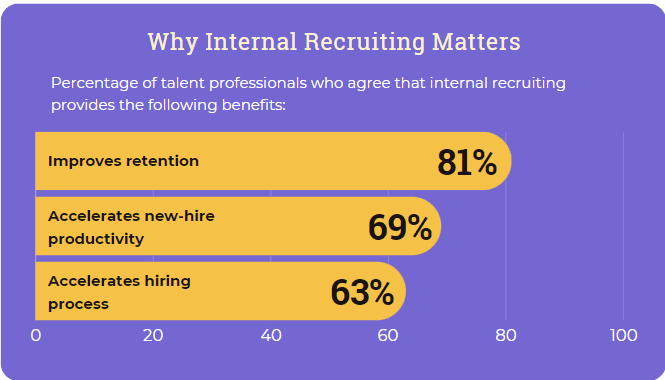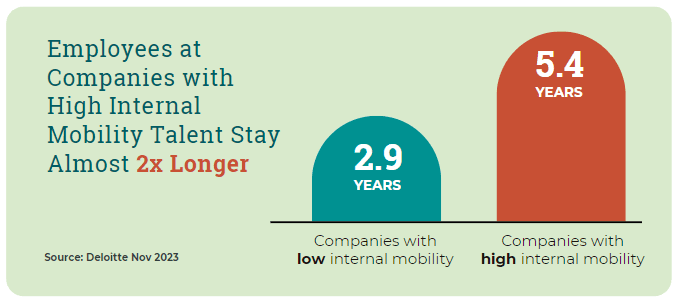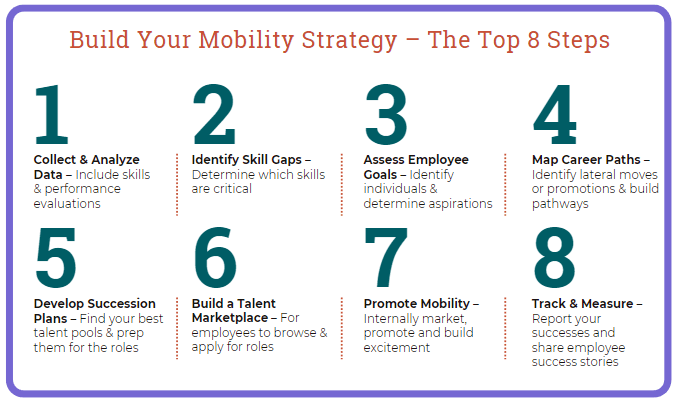The workforce is constantly changing, and for organizations the need to effectively leverage internal mobility not only saves money but also fosters employee satisfaction, creating a continuous cycle of talent solutions. By using talent analytics, workforce teams can base mobility decisions on an enhanced understanding of how to address this challenge.
Horsefly Analytics delivers the insights needed to master the talent mobility challenge. By providing a comprehensive view of workforce data, our platform empowers HR teams to make informed decisions that enhance internal mobility strategies. With detailed analytics on skill gaps, employee potential, and future talent trends, Horsefly Analytics helps organizations identify the right opportunities for internal advancement.
This approach not only mitigates the risk of losing key talent to competitors but also optimizes the development of a cohesive and motivated workforce.
The Talent Mobility Challenge
For employers, talent mobility isn't just a fancy buzzword…
…it presents significant challenges and ongoing threats to growth. The risk of losing key employees to competitors is a continuous issue as is the subsequent cost to the business of external recruitment. Mismanaged mobility can lead to decreased employee morale, increased turnover, and a lack of coherence in organizational culture.
Organizations like IBM and Deloitte have used talent mobility as a central success strategy.
They have demonstrated that offering employees opportunities for advancement and rewards reduces the need for them to leave. Talent mobility is not just about retention; it is about developing happy, productive workforces that grow and expand within the organization

The Top 3 Benefits of Talent Mobility
The Value of Talent Mobility
-
Enhanced Employee Engagement: When people feel like they're on a career path they are engaged and productivity levels are significantly improved for example engaged employees show a 41% reduction in absenteeism. They are motivated, fostering a sense of belonging and commitment.
-
Increased Retention Rates: Your talent is more likely to stick around for the long haul. Organizations experience 59% less turnover with progressive mobility strategies in place.
-
Enhanced Organizational Agility: Mobility enables nimble responses as companies can adapt more swiftly to changing market dynamics by deploying skilled professionals where they're needed most.

For Employees
-
Career Growth Opportunities: Talent mobility offers diverse pathways for advancement and skill enhancement. Whether it's moving laterally to gain cross-functional expertise or planning for a promotional pathway.
-
Skill Diversification: Exposure to different roles and responsibilities cultivates a versatile skill set. From mastering new technologies to honing leadership capabilities.
-
Work-Life Integration: Mobility benefits like flexible working significantly promote a healthier work-life balance.

Organizations Who Have Mastered it!
It’s good to know which organizations out there are doing it right. These two use cases underscore the transformative impact of talent mobility on workforce management and organizational success.

-
Google encourages internal mobility to nurture talent and encourage innovation. For example, they allow their engineers to spend 20% of their time on personal tech projects that interest them, which fosters innovative approaches, new skill development and fosters trust.
-
General Electric (GE), is renowned for its GE Leadership Development Program designed to groom future leaders through rotational assignments across different business units.

Using Your Data & Horsefly Analytics
When covering each central mobility strategy, remember that data collation and sharing are crucial. Platforms like Horsefly enable you to gather and share external data, building customized reports using tools like Excel, Tableau, Power BI, and more. This flexibility allows for effective data collection and sharing during mobility planning.
The role of a talent analytics partner is to enable talent and workforce planning professionals to make the most effective and data-driven decisions when determining if they should look externally to fill open roles or entirely new positions. To build a mobility strategy these are some of the key areas to focus on:
-
Collect and analyze talent data. Include skills, experiences, performance evaluations, and career aspirations. Utilize HR systems with surveys, and feedback mechanisms to gather comprehensive data. Horsefly's API effortlessly taps into our extensive data, expanding beyond the Horsefly Labor Market Intelligence platform to synergize with other workforce tools so you can see the full scope of internal talent enabling exploration of all mobility potential.
-
Identify skill gaps and surplus. Find skill shortages or surpluses within the organization. Determine which skills are critical for your business. Deepen your understanding of your workforce within your internal proprietary systems.
-
Assess employee preferences and career goals. Understand the career aspirations and preferences of your employees. Identify individuals who are interested in exploring new roles
-
Map potential career paths. Horsefly's Career Path Data offers an interactive tree chart revealing the typical career paths talent follows. Identify pathways for employees to develop their skills and advance their careers through lateral moves, promotions, or cross-functional assignments.
To listen to how Liverpool City Region unlocked precise career insights with Horsefly’s granular data analytics, take a look at this video.
-
Develop succession plans. Determine who has the potential to fill key leadership roles in the future and ensure that they receive the necessary development and experiences to prepare them for these positions.
-
Create a talent marketplace. Connect employees with opportunities where they can browse job openings, express interest, and apply for internal positions.
-
Promote a culture of mobility. Communicate across your organization the development opportunities available to employees at all levels of the organization. Create buzz – it’s a great brand and business opportunity.
-
Track and measure progress. Report your successes! Track metrics such as employee engagement, retention rates, internal mobility rates, and skill development to assess the impact of talent mobility initiatives.

It doesn’t make sense to hire smart people and tell them what to do; we hire smart people so they can tell us what to do.
Steve Jobs
Apple
Delivering Your Mobility Solution
An organization’s data should be embedded in every decision, interaction and process, with mobility central to these programs of work. Some analytics highlights for mobility would be:
-
Talent analytics for ‘Job Title Projections’ – gain insights into the most common market career pathways and inform your organization’s efforts to develop internal employee development programs.
-
Utilize ‘Keyword Functionality’ to better understand the most common skills and job responsibilities for your own internal job infrastructure and development pathways.
-
Explore ‘Talent Supply & Demand Data’ which identifies job profiles or skill sets that may be difficult or costly to recruit externally, and may confirm the need for increased investment into the internal talent market.
We want to create an environment where every employee can bring their whole self to work and not just make a living, but also have a life.
Indra Nooyi
Pepsico's CEO
Take the First Step. It's FREE:
Take a no-obligation jump into mobility planning and connect with our team. We’d love to hear from you.
Sources: Forbes, Horsefly Analytics, Deloitte, McKinsey & Company, Lever 2022 Report – The Great Resignation.
.
Get Started With Horsefly Today
